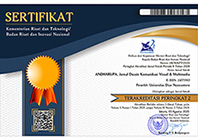Pengaruh Psikologi Kombinasi Warna Dalam Website
DOI:
https://doi.org/10.33633/andharupa.v1i01.956Abstract
Website terdiri dari dua hal penting, yang terlihat dan yang tak terlihat. Hal yang terlihat adalah user interface. Warna merupakan salah satu hal yang bertanggung jawab pada sebuah interface. Sehingga untuk membuat sebuah website pemilihan terhadap warna sangat penting. Hal ini juga dikuatkan oleh Institut untuk research warna dalam Krischer disampaikan bahwa user memberikan penilaian dibawah sadar terhadap website dalam waktu 90 detik, dan 90% penilaian berdasar pada warna. Dengan menggunakan metode deskriptif kualitatif data-data yang didapat dari studi literatur mengenai teori psikologi warna Goethe dan Itten dipetakan kedalam teori kombinasi warna sehingga didapat kesan yang muncul dari psikologi kombinasi warna pada website. Kata Kunci: psikologi warna, kombinasi warna, websiteDownloads
Published
2015-02-18
Issue
Section
Articles
License
Copyright (c) 2015 ANDHARUPA: Jurnal Desain Komunikasi Visual & Multimedia

This work is licensed under a Creative Commons Attribution 4.0 International License.
Authors who publish with this journal agree to the following terms:
- Authors retain copyright and grant the journal right of first publication with the work simultaneously licensed under a Creative Commons Attribution License that allows others to share the work with an acknowledgment of the work's authorship and initial publication in this journal.
- Authors are able to enter into separate, additional contractual arrangements for the non-exclusive distribution of the journal's published version of the work (e.g., post it to an institutional repository or publish it in a book), with an acknowledgment of its initial publication in this journal.
- Authors are permitted and encouraged to post their work online (e.g., in institutional repositories or on their website) prior to and during the submission process, as it can lead to productive exchanges, as well as earlier and greater citation of published work (See The Effect of Open Access).















